Abstract
Background
Superficial surgical site infections (SSSIs) are a major reason for morbidity after abdominal surgery. Microbiologic isolates of SSSIs vary widely geographically. Therefore, knowledge about the specific bacterial profile is of paramount importance to prevent SSSI.
Methods
We performed a subgroup analysis of the microbiological isolates from patients with SSSI after abdominal surgery that were included in our institutional wound register. We aimed at identifying predominant strains as well as risk factors that would predispose for SSSI with certain bacteria.
Results
A total of 494 patients were eligible for analysis. Of those 313 had received wound swaps, with 268 patients yielding a bacterial isolate. Enterobacterales (31.7%) and Enterococcus spp. (29.5%) were found as main bacteria in SSSI, with 62.3% of the wounds being polymicrobial. As risk factors for changes in bacterial isolates, we identified operative revision (OR 3.032; 95%CI 1.734–5.303) in multivariate analysis. Enterococcus spp. showed a significant increase in patients after revision surgery (p<0.001). Antibiotic therapy was neither influential on bacterial changes nor on the presence of Enterococcus spp. in SSSI.
Conclusion
Our study accentuates the high frequency of Enterococcus spp. in SSSI after abdominal surgery, while identifying surgical revision as major risk factor. The results urge vigilance in the treatment of patients with surgical revisions to include Enterococcus spp. in the prevention and treatment strategies.

Similar content being viewed by others
References
1. Furukawa K, Onda M, Suzuki H, Maruyama H, Akiya Y, Ashikari M, Maezawa K, Tokunaga A, Tajiri T, Tanaka N, Yamasita K (1999) The usefulness of conducting investigations on intra-abdominal bacterial contamination in digestive tract operations. Surg Today 29 (8):701-706. https://doi.org/10.1007/bf02482312
Atkinson A, Eisenring MC, Troillet N, Kuster SP, Widmer A, Zwahlen M, Marschall J (2021) Surveillance quality correlates with surgical site infection rates in knee and hip arthroplasty and colorectal surgeries: A call to action to adjust reporting of SSI rates. Infect Control Hosp Epidemiol 1-7. https://doi.org/10.1017/ice.2021.14
Slowik R, Kolpa M, Walaszek M, Rozanska A, Jagiencarz-Starzec B, Zienczuk W, Kawik L, Wolak Z, Wojkowska-Mach J (2020) Epidemiology of Surgical Site Infections Considering the NHSN Standardized Infection Ratio in Hip and Knee Arthroplasties. Int J Environ Res Public Health 17 (9). https://doi.org/10.3390/ijerph17093167
4. Vicentini C, Corradi A, Scacchi A, Elhadidy H, Furmenti MF, Quattrocolo F, Zotti CM (2020) Impact of a bundle on surgical site infections after hip arthroplasty: A cohort study in Italy (2012-2019). Int J Surg 82:8-13. https://doi.org/10.1016/j.ijsu.2020.07.064
5. Anjum N, Ren J, Wang G, Li G, Wu X, Dong H, Wu Q, Li J (2017) A Randomized Control Trial of Preoperative Oral Antibiotics as Adjunct Therapy to Systemic Antibiotics for Preventing Surgical Site Infection in Clean Contaminated, Contaminated, and Dirty Type of Colorectal Surgeries. Diseases of the colon and rectum 60 (12):1291–1298. https://doi.org/10.1097/dcr.0000000000000927
6. Pham H, Chen A, Nahm CB, Lam V, Pang T, Richardson AJ (2021) The Role of Targeted Versus Standard Antibiotic Prophylaxis in Pancreatoduodenectomy in Reducing Postoperative Infectious Complications: A Systematic Review and Meta-analysis. Ann Surg. https://doi.org/10.1097/sla.0000000000004816
7. Robb KA, Habiyakare C, Kateera F, Nkurunziza T, Dusabe L, Kubwimana M, Powell B, Koch R, Gruendl M, Ngamije P, Riviello R, Hedt-Gauthier B (2020) Variability of water, sanitation, and hygiene conditions and the potential infection risk following cesarean delivery in rural Rwanda. J Water Health 18 (5):741-752. https://doi.org/10.2166/wh.2020.220
8. Berrios-Torres SI, Umscheid CA, Bratzler DW, Leas B, Stone EC, Kelz RR, Reinke CE, Morgan S, Solomkin JS, Mazuski JE, Dellinger EP, Itani KMF, Berbari EF, Segreti J, Parvizi J, Blanchard J, Allen G, Kluytmans J, Donlan R, Schecter WP, Healthcare Infection Control Practices Advisory C (2017) Centers for Disease Control and Prevention Guideline for the Prevention of Surgical Site Infection, 2017. JAMA Surg 152 (8):784-791. https://doi.org/10.1001/jamasurg.2017.0904
9. Wacha H, Hoyme U, Isenmann R, Kujath P, Lebert C, Naber K, Salzberger B (2010) Perioperative Antibiotika-Prophylaxe; Empfehlungen einer Expertenkommission der Paul-Ehrlich-Gesellschaft für Chemotherapie e.V. Chemother J 19:70-84
10. Sugiura T, Uesaka K, Ohmagari N, Kanemoto H, Mizuno T (2012) Risk factor of surgical site infection after pancreaticoduodenectomy. World J Surg 36 (12):2888-2894. https://doi.org/10.1007/s00268-012-1742-6
11. Zejnullahu VA, Isjanovska R, Sejfija Z, Zejnullahu VA (2019) Surgical site infections after cesarean sections at the University Clinical Center of Kosovo: rates, microbiological profile and risk factors. BMC Infect Dis 19 (1):752. https://doi.org/10.1186/s12879-019-4383-7
12. Eisner R, Lippmann N, Josten C, Rodloff AC, Behrendt D (2020) Development of the Bacterial Spectrum and Antimicrobial Resistance in Surgical Site Infections of Trauma Patients. Surg Infect (Larchmt) 21 (8):684-693. https://doi.org/10.1089/sur.2019.158
13. Pal S, Sayana A, Joshi A, Juyal D (2019) Staphylococcus aureus: A predominant cause of surgical site infections in a rural healthcare setup of Uttarakhand. J Family Med Prim Care 8 (11):3600-3606. https://doi.org/10.4103/jfmpc.jfmpc_521_19
14. Shah S, Singhal T, Naik R (2015) A 4-year prospective study to determine the incidence and microbial etiology of surgical site infections at a private tertiary care hospital in Mumbai, India. Am J Infect Control 43 (1):59-62. https://doi.org/10.1016/j.ajic.2014.10.002
15. Roumbelaki M, Kritsotakis EI, Tsioutis C, Tzilepi P, Gikas A (2008) Surveillance of surgical site infections at a tertiary care hospital in Greece: incidence, risk factors, microbiology, and impact. Am J Infect Control 36 (10):732-738. https://doi.org/10.1016/j.ajic.2007.11.009
16. Mofikoya BO, Niemogha MT, Ogunsola FT, Atoyebi OA (2011) Predictors of surgical site infections of the abdomen in Lagos, Nigeria. Nig Q J Hosp Med 21 (2):124-128
17. Múñez E, Ramos A, Espejo T, Vaqué J, Sánchez-Payá J, Pastor V, Asensio A (2011) [Microbiology of surgical site infections in abdominal tract surgery patients]. Cir Esp 89 (9):606-612. https://doi.org/10.1016/j.ciresp.2011.05.008
18. Nahid MA, Griffin JM, Lustik MB, Hayes JJ, Fong KSK, Horseman TS, Menguito M, Snesrud EC, Barnhill JC, Washington MA (2021) A Longitudinal Evaluation of the Bacterial Pathogens Colonizing Chronic Non-Healing Wound Sites at a United States Military Treatment Facility in the Pacific Region. Infect Drug Resist 14:1-10. https://doi.org/10.2147/IDR.S260708
19. Kwa KAA, Krijnen P, Bernards AT, Schipper IB, Meij-de Vries A, Breederveld RS (2020) Bacterial Species and Load Increase During Negative Pressure Wound Therapy: A Prospective Cohort Study. Wounds 32 (3):74-80
Surgical Site Infection Event (SSI) (2021) American Center for Disease Control and Prevention. https://www.cdc.gov/nhsn/pdfs/pscmanual/9pscssicurrent.pdf. Accessed 23.08.2021
The European Committee on Antimicrobial Susceptibility and Testing. Breakpoint tables for Interpretation of MICs and zone diameters. version 11.0 (2021) http://www.eucast.org. Accessed 06.04.2021
22. Alkaaki A, Al-Radi OO, Khoja A, Alnawawi A, Alnawawi A, Maghrabi A, Altaf A, Aljiffry M (2019) Surgical site infection following abdominal surgery: a prospective cohort study. Can J Surg 62 (2):111-117. https://doi.org/10.1503/cjs.004818
23. Pochhammer J, Kramer A, Schäffer M (2017) [Enterococci and surgical site infections : Causal agent or harmless commensals?]. Chirurg 88 (5):377-384. https://doi.org/10.1007/s00104-017-0388-1
24. Aktas A, Kayaalp C, Gunes O, Gokler C, Uylas U, Cicek E, Ersoy Y, Kose A, Bayindir Y, Aydin C, Yilmaz S (2019) Surgical site infection and risk factors following right lobe living donor liver transplantation in adults: A single-center prospective cohort study. Transpl Infect Dis 21 (6):e13176. https://doi.org/10.1111/tid.13176
25. Greenhalgh DG, Saffle JR, Holmes JHt, Gamelli RL, Palmieri TL, Horton JW, Tompkins RG, Traber DL, Mozingo DW, Deitch EA, Goodwin CW, Herndon DN, Gallagher JJ, Sanford AP, Jeng JC, Ahrenholz DH, Neely AN, O'Mara MS, Wolf SE, Purdue GF, Garner WL, Yowler CJ, Latenser BA (2007) American Burn Association consensus conference to define sepsis and infection in burns. J Burn Care Res 28 (6):776-790. https://doi.org/10.1097/BCR.0b013e3181599bc9
26. Thet NT, Mercer-Chalmers J, Greenwood RJ, Young AER, Coy K, Booth S, Sack A, Jenkins ATA (2020) SPaCE Swab: Point-of-Care Sensor for Simple and Rapid Detection of Acute Wound Infection. ACS Sens 5 (8):2652-2657. https://doi.org/10.1021/acssensors.0c01265
27. Itani KM, Wilson SE, Awad SS, Jensen EH, Finn TS, Abramson MA (2006) Ertapenem versus cefotetan prophylaxis in elective colorectal surgery. N Engl J Med 355 (25):2640-2651. https://doi.org/10.1056/NEJMoa054408
28. Deierhoi RJ, Dawes LG, Vick C, Itani KMF, Hawn MT (2013) Choice of Intravenous Antibiotic Prophylaxis for Colorectal Surgery Does Matter. Journal of the American College of Surgeons 217 (5):763-769. https://doi.org/10.1016/j.jamcollsurg.2013.07.003
29. Hoffman T, Lellouche J, Nutman A, Temkin E, Frenk S, Harbarth S, Carevic B, Cohen-Percia S, Kariv Y, Fallach N, Klausner J, Carmeli Y (2021) The effect of prophylaxis with ertapenem versus cefuroxime/metronidazole on intestinal carriage of carbapenem-resistant or third-generation-cephalosporin-resistant Enterobacterales after colorectal surgery. Clin Microbiol Infect. https://doi.org/10.1016/j.cmi.2021.02.002
30. Bagley DH, Mac Lowry J, Beazley RM, Gorschboth C, Ketcham AS (1978) Antibiotic concentration in human wound fluid after intravenous administration. Ann Surg 188 (2):202-208. https://doi.org/10.1097/00000658-197808000-00013
31. Resino E, San-Juan R, Aguado JM (2016) Selective intestinal decontamination for the prevention of early bacterial infections after liver transplantation. World J Gastroenterol 22 (26):5950-5957. https://doi.org/10.3748/wjg.v22.i26.5950
32. Mikkelsen KH, Frost M, Bahl MI, Licht TR, Jensen US, Rosenberg J, Pedersen O, Hansen T, Rehfeld JF, Holst JJ, Vilsboll T, Knop FK (2015) Effect of Antibiotics on Gut Microbiota, Gut Hormones and Glucose Metabolism. PLoS One 10 (11):e0142352. https://doi.org/10.1371/journal.pone.0142352
Acknowledgements
We appreciate the support of our wound care specialists who have supported this study and who are eager in supplying the best care possible for our SSI patients.
Author information
Authors and Affiliations
Corresponding author
Ethics declarations
Conflict of Interest
The authors declare no competing interests.
Additional information
Publisher's Note
Springer Nature remains neutral with regard to jurisdictional claims in published maps and institutional affiliations.
Matthias Mehdorn and Woubet Tefera Kassahun contributed equally to this work and are both considered to be first authors.
Rights and permissions
About this article
Cite this article
Mehdorn, M., Kassahun, W.T., Lippmann, N. et al. Surgical Revision Promotes Presence of Enterococcus spp. in Abdominal Superficial Surgical Site Infections. J Gastrointest Surg 26, 444–452 (2022). https://doi.org/10.1007/s11605-021-05170-3
Received:
Accepted:
Published:
Issue Date:
DOI: https://doi.org/10.1007/s11605-021-05170-3




